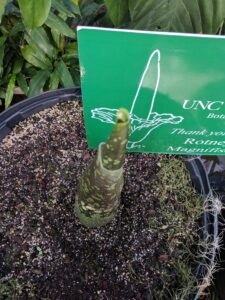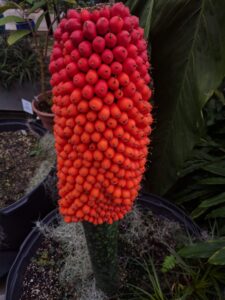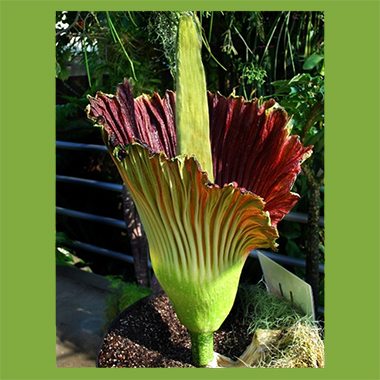Update May 2020:
Introducing Rotney the Magnifiscent – the second! This bud started growing in April, and we believe that it will bloom in early June. While the Greenhouse is currently closed to the public, you can watch Rotney’s progression here!
Update 5/29/20: Oh ROTNEY… some of you may have noticed that Rotney is looking a little… different… than his last bloom. As he entered into his rapid growth phase over the last couple of days, it has become evident that at some point in his development, there was a malformation in the structure of the spadix. While the spadix typically grows straight up, Rotney’s spadix is growing in an unusual direction. At this point, we don’t believe that he will grow straight upwards as usual. However, we do expect that he will still bloom. The unusual circumstances of his development make it hard to predict what that bloom will look like, or when it will happen. We are all interested to see how this plant will continue to develop! Stay tuned with us and cheer him on!
Update 6/8: Rotney started to open on Saturday, June 6, 2020 around 11:30 a.m. and reached full bloom overnight. He is now closing, and the structure will eventually collapse over the next few days. Thanks for tuning in!
You can see the opening of the bloom here:
To donate to “Rotney’s College Fund,” go here: https://ecom.uncc.edu/C21561_ustores/web/classic/product_detail.jsp?PRODUCTID=1066&SINGLESTORE=true
Read more about our titans below!

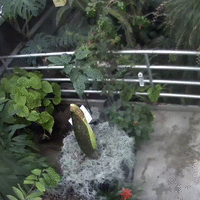 Titan Arums are only found in the jungles of Sumatra and produce the world’s largest floral structures—imagine rounding a bend in the jungle and encountering a flower taller than you (unless you’re 10 feet tall!). Of course, they’d be hard to sneak up on when open, as the rotting meat odor coming from the fully open bloom can travel up to a half-mile away. It’s no wonder when they bloom in captivity at gardens around the world they draw in admirers who must see (and smell) it to believe this larger-than-life botanical spectacle! Titans normally open in the evening and the intense odor only lasts for 12 hours. The bloom will stay open (with a much lighter odor) for only 1-2 days. The plant must reach 10-15 years of age before it blooms for the first time and then blooms every 3-5 years thereafter.
Titan Arums are only found in the jungles of Sumatra and produce the world’s largest floral structures—imagine rounding a bend in the jungle and encountering a flower taller than you (unless you’re 10 feet tall!). Of course, they’d be hard to sneak up on when open, as the rotting meat odor coming from the fully open bloom can travel up to a half-mile away. It’s no wonder when they bloom in captivity at gardens around the world they draw in admirers who must see (and smell) it to believe this larger-than-life botanical spectacle! Titans normally open in the evening and the intense odor only lasts for 12 hours. The bloom will stay open (with a much lighter odor) for only 1-2 days. The plant must reach 10-15 years of age before it blooms for the first time and then blooms every 3-5 years thereafter.
Rotney’s Second Bloom
- Rotney in a leaf cycle
- 4/3/20
- 4/21/20
- 4/28/20
- 5/5/20
- 5/20/20
- 5/25/20
Odie’s Second Bloom
Not to be outdone by his “twin” Rotney, the Botanical Gardens’ other mature titan arum Odie put up a flower that bloomed on May 24th, 2018! Many visitors that came to view Rotney returned to view Odie, some for the second time! Odie reached a mature height of 5’4.5″. The flower was a beautiful bright green and red and the bloom progressed much faster than Rotney and smelled stronger. On the evening of May 24th, Greenhouse Manager Tammy Blume and volunteer and titan enthusiast Mariah Huffman attempted pollination by hand with pollen that was collected three weeks earlier from Rotney. This pollination was successful, and Odie produced beautiful orange and red berries, which you can see below. These seeds were collected and some were used to start new plants for our collection, while others were shared with other institutions all over the country.
Rotney the Magnifiscent – First Bloom
Rotney bloomed on May 3rd, 2018. At approximately 9:45pm, Orchid Curator Mary Duke attempted hand pollination with pollen from Ohio State University’s “Scarlet.” This pollination was not successful. However, we were able to collect pollen from the male flowers of Rotney, which were used to pollinate Odie during his second bloom about 3 weeks later, and that pollination WAS successful. Over 2,000 people came through McMillan Greenhouse to view Rotney, the third titan arum to bloom in the history of the UNC Charlotte Botanical Gardens.
| April 3, 2018 |
 |
| April 21, 2018 | ||
 |
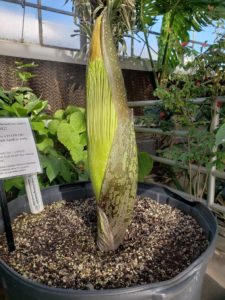 |
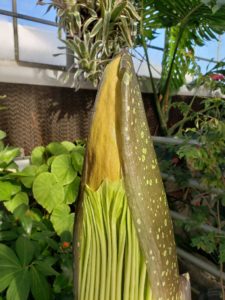 |
| April 27, 2018 | April 30, 2018 |
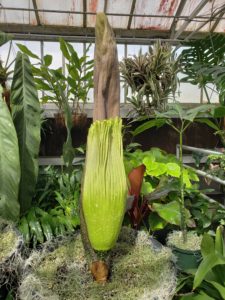 |
 |
| May 3, 2018 | |
 |
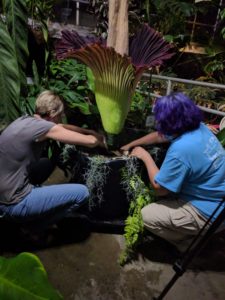 |
| May 4, 2018 | May 5, 2018 | |
 |
 |
 |
Odie, first bloom
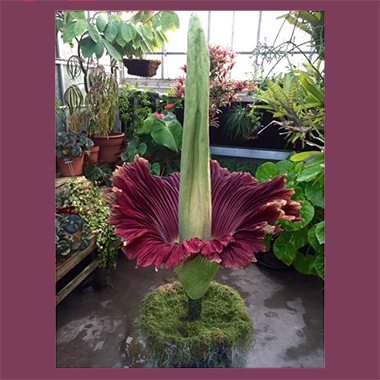 Odie began unfurling at approximately 12:30 pm on Friday July 17th, 2015, and was open by 8:00 pm, filling the greenhouse with a pungent odor of dead animal mixed with burnt sugar. By 11:00 pm the spathe opened even wider and flattened out. This is when John Denti attempted pollination (at full odor intensity!). Saturday morning the spathe began to draw back in, displaying a beautiful form. This short-lived bloom is as expected and part of the allure of this amazing plant. Years worth of energy go into a gigantic display designed for one night only!
Odie began unfurling at approximately 12:30 pm on Friday July 17th, 2015, and was open by 8:00 pm, filling the greenhouse with a pungent odor of dead animal mixed with burnt sugar. By 11:00 pm the spathe opened even wider and flattened out. This is when John Denti attempted pollination (at full odor intensity!). Saturday morning the spathe began to draw back in, displaying a beautiful form. This short-lived bloom is as expected and part of the allure of this amazing plant. Years worth of energy go into a gigantic display designed for one night only!
Timelapse of Odie Blooming
Bella
Bella bloomed for the second time in her life June 22-June 24, 2010. Her first bloom was in 2007.
Thank you to everyone who came out to share in her spectacle and to support the greenhouse and gardens (her humble caretakers)!
Like a chance siting of a movie star, you can hardly believe you are seeing a celebrity before she has ducked into a limo and driven off. We believe the super-high temperatures contributed to Bella’s rapid aging (we were all fading quickly in the heat!). Most likely she was fully open and at her stinkiest during the middle of the night between Tuesday the 22nd & Wednesday the 23rd. By the end of the 24th, her petal-like spathe was withered and we pronounced the bloom over on the 25th. Thanks to the speed of communications these days, the word got out quickly and we estimate that we had about 4,000 visitors over a three day period.
FAQ
Where does the Titan Arum come from?
The Titan Arum grows in the moist, shady jungles of Sumatra, Indonesia.
What a weird looking flower. Is it really the largest flower in the world?
The Titan Arum produces the largest unbranched, inflorescence in the world. The largest of these recorded in cultivation was over 9.5 ft tall! An inflorescence is a structure containing multiple flowers. The Titan Arum bears a special type of inflorescence that looks like one gigantic flower. The tall slender central spike actually bears hundreds of tiny male and female flowers at its base. These little flowers at the base of the spike are hidden by the pleated sheath surrounding it. This sheath will open up at bloom and look like a sort of giant, frilly, maroon petal. Botanists call this sheath and spike type of inflorescence a “spathe and spadix.”
Plants that produce these spathe and spadix blooms are in the arum family of plants. A local member of this family is the woodland “Jack-in-the-pulpit.” Jack is the spadix and his pulpit is the spathe.
Does it really smell that bad?
Yes, but not for long! The plant produces waves of odor that have been variously described as smelling of rotting animal, dung, and rancid cheese. The Indonesian name for the Titan translates as “corpse flower.” Thankfully, these odors are only produced for 8 to 24 hours, corresponding to the “ripening” of the tiny female flowers, followed by the tiny male flowers at the base of the spike. In the wild, the odor can carry for up to a half-mile attracting specific pollinators. Scientists have observed carrion beetles, carrion flies, and sweat bees visiting the Titan Arum in Sumatra.
How old is your Titan?
We have two Titans: “Odie,” who bloomed in 2015, and Odie’s “twin” who has not been named yet, and appears to be preparing to bloom this Spring! We acquired the “twins” in 2008, and they were about 2 years old then.
Our old titan arum, “Bella” bloomed in 2007 and again in 2010 before she died. In the wild, individuals are estimated to bloom 3-6 times in a 40-yr life span. Plants in cultivation almost never live that long.
Where did you get “Bella”, your first Titan Arum plant?
We got ours as a small tuber from Tony Avent, of Plant Delights Nursery in Raleigh. Tony is a fan of many plants in the same genus as the Titan Arum. Some species of Amorphophallus are actually winter-hardy in the Carolinas. These plants are much smaller than the Titan Arum, but still fascinating, and even smelly in their own right. The Titan Arum is extremely sensitive to cold and must never be exposed to temperatures below 50° F.
Why did you name her Bella? … Is it really a “she”?
Bella is actually an “it or “they” because the “flower” is both male and female. Akin to naming a child, we decided on “Bella” for several reasons. Bella is Latin for beautiful, and we are so proud of this flower that, despite its smell, we can only think of it as wonderfully beautiful. Additionally, the shape of the spathe surrounding the spike is that of an inverted Bell.
Is it rare?
In its natural habitat it has a limited range, but until recently was uncommon (but not rare) within that range. Unfortunately it is now becoming rarer and rarer. Due to habitat destruction and illegal collecting of the tubers. A good number of botanical gardens around the world (and even individuals) have specimens, but they require specific growing conditions to thrive, and there is no guarantee they will ever bloom. Being lucky enough to have one bloom in cultivation is the rarity.
Where are the stems and leaves of this plant?
The Titan Arum grows out of a large, underground corm, which is very much like a bulb or tuber. The corm is actually a compressed underground stem that looks like a roundish, flattened potato. The corms of some Titans have weighed in at over 200 lbs!
At different stages during its life the Titan’s corm is either dormant underground, or bearing a giant compound leaf or a solitary, giant inflorescence. In other words, the leaf and the flower never exist on the plant at the same time. After the Titan blooms, its amazing “flower” will wither and collapse, but the corm below ground will remain. After a short period a giant leaf will emerge. The leaf is spectacular in its own right. Its stalk is up to 12’ tall (taller in the wild), colored with splotches in shades of green and cream, and appearing somewhat like a giant, lacy umbrella. Although it looks like a weird sort of tree, it is truly just one giant, compound leaf! The leaf can last up to a year before it turns yellow and dies. Then the plant must go through a period of rest (dormancy). During this time it exists only as the underground corm.
Where can I find out more about the Titan Arum?
The web is full of information on this fascinating, dramatic plant. Most gardens and universities that have had one bloom have pictures and information. Search for “Titan Arum” or “Amorphophallus titanum” Enjoy!








